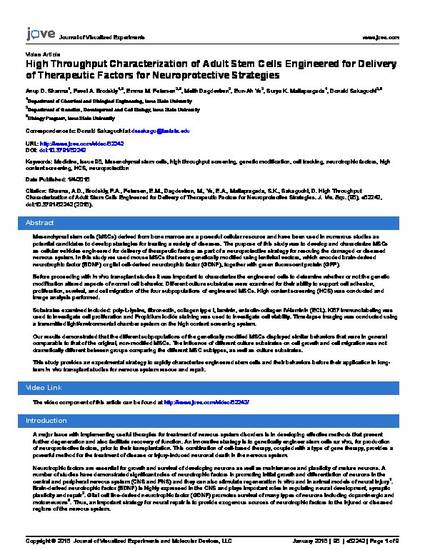
Mesenchymal stem cells (MSCs) derived from bone marrow are a powerful cellular resource and have been used in numerous studies as potential candidates to develop strategies for treating a variety of diseases. The purpose of this study was to develop and characterize MSCs as cellular vehicles engineered for delivery of therapeutic factors as part of a neuroprotective strategy for rescuing the damaged or diseased nervous system. In this study we used mouse MSCs that were genetically modified using lentiviral vectors, which encoded brain-derived neurotrophic factor (BDNF) or glial cell-derived neurotrophic factor (GDNF), together with green fluorescent protein (GFP).
Before proceeding with in vivo transplant studies it was important to characterize the engineered cells to determine whether or not the genetic modification altered aspects of normal cell behavior. Different culture substrates were examined for their ability to support cell adhesion, proliferation, survival, and cell migration of the four subpopulations of engineered MSCs. High content screening (HCS) was conducted and image analysis performed.
Substrates examined included: poly-L-lysine, fibronectin, collagen type I, laminin, entactin-collagen IV-laminin (ECL). Ki67 immunolabeling was used to investigate cell proliferation and Propidium Iodide staining was used to investigate cell viability. Time-lapse imaging was conducted using a transmitted light/environmental chamber system on the high content screening system.
Our results demonstrated that the different subpopulations of the genetically modified MSCs displayed similar behaviors that were in general comparable to that of the original, non-modified MSCs. The influence of different culture substrates on cell growth and cell migration was not dramatically different between groups comparing the different MSC subtypes, as well as culture substrates.
This study provides an experimental strategy to rapidly characterize engineered stem cells and their behaviors before their application in longterm in vivo transplant studies for nervous system rescue and repair.
Available at: http://works.bepress.com/mallapragada_surya_k/47/

This article is from Journal of Visualized Experiments (2015): e52242, doi: 10.3791/52242. Posted with permission.